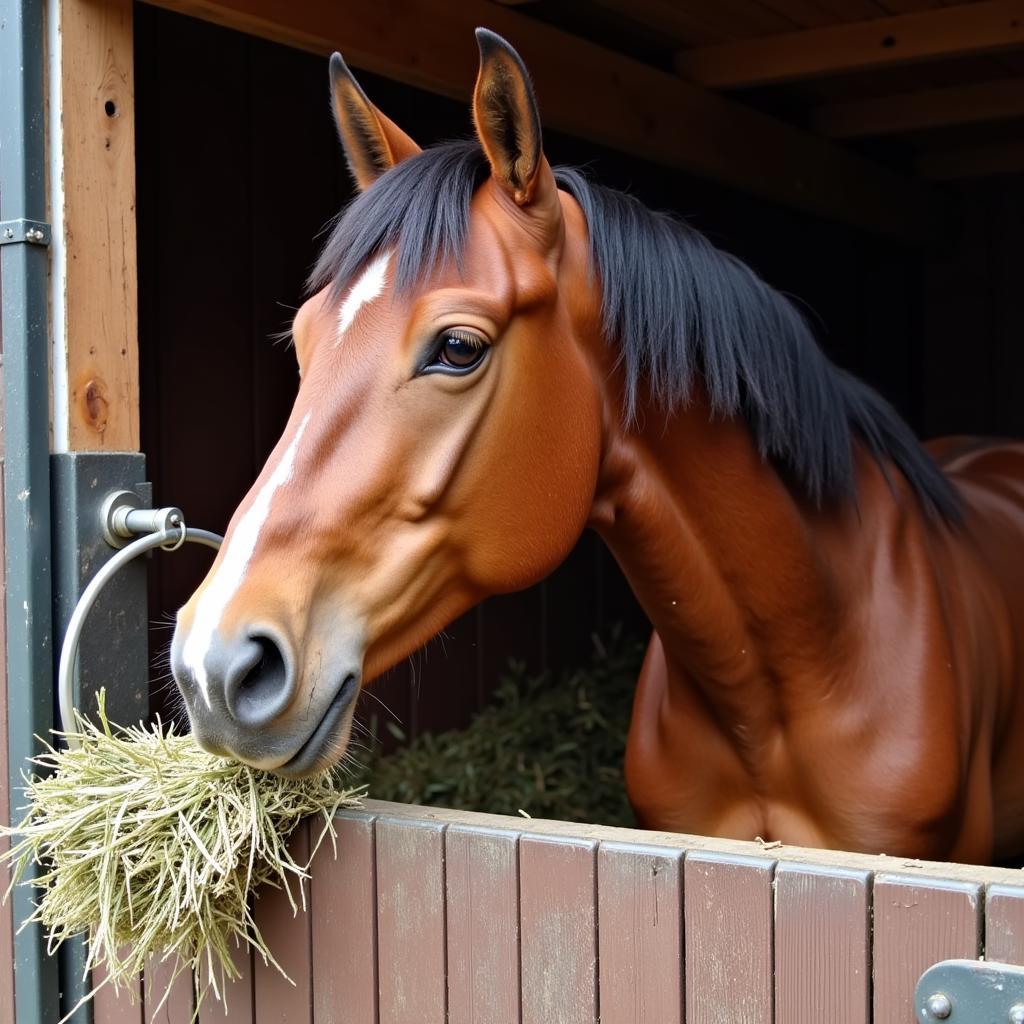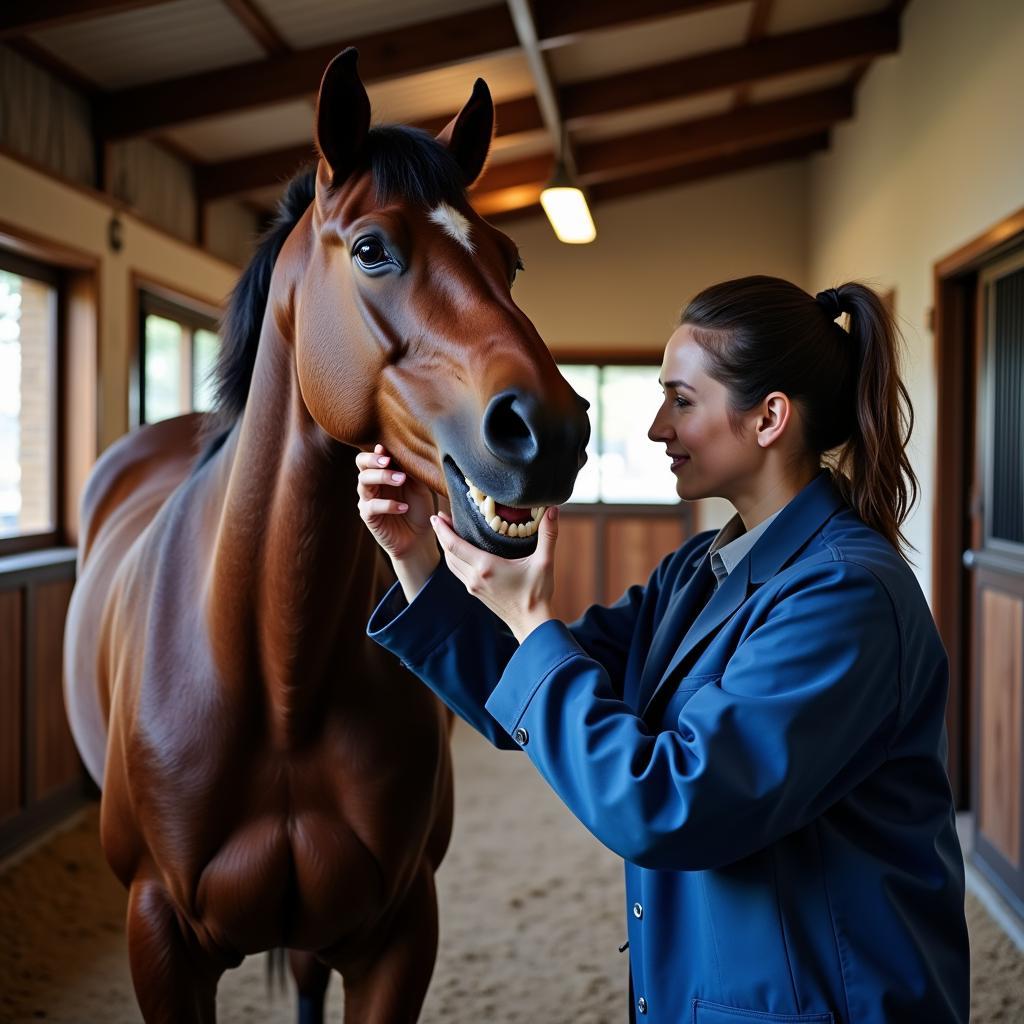Horse Hay Rings are a staple for many horse owners, offering a practical and efficient way to feed your equine companions. But with so many options available, selecting the right hay ring for your horse’s needs and your stable setup can feel overwhelming. This comprehensive guide will explore everything you need to know about horse hay rings, from the different types and their benefits to choosing the right size and material.
Understanding the Importance of Horse Hay Rings
 Horse Eating Hay From a Ring in Its Stable
Horse Eating Hay From a Ring in Its Stable
Horses are natural grazers, designed to eat small amounts of forage throughout the day. Hay rings play a crucial role in replicating this natural grazing pattern, especially for stabled horses who don’t have access to pasture. Using hay rings offers several benefits:
- Reduces Hay Waste: Hay rings minimize wastage by preventing horses from trampling and soiling their hay. This is particularly important for horses on controlled diets or those prone to respiratory issues aggravated by dusty hay.
- Promotes Digestive Health: By slowing down consumption, hay rings help regulate a horse’s digestive system and prevent overeating, which can lead to colic and other health issues.
- Maintains a Clean Environment: Containing hay within a ring keeps the stable cleaner and reduces the risk of respiratory problems caused by airborne dust and mold spores.
Types of Hay Rings: Finding the Perfect Fit for Your Stable
The ideal hay ring depends on your horse’s size, eating habits, and your stable setup. Here are the most common types:
- Wall-Mounted Hay Rings: These rings attach to the stall wall, saving valuable floor space and minimizing the risk of the ring being tipped over. They are ideal for smaller spaces and horses that are not prone to pawing or pulling at their feeders.
- Free-Standing Hay Rings: As the name suggests, these rings stand independently on the ground. They are suitable for larger stables and paddocks, offering greater flexibility in positioning. However, they can be knocked over by boisterous horses.
- Hay Baskets and Nets: These provide a more enclosed option for feeding hay, further reducing waste and slowing down consumption. Hay nets can be hung from the ceiling or a sturdy beam, while hay baskets are typically placed on the ground.
Choosing the Right Material: Durability and Safety First
Hay rings are made from various materials, each with pros and cons:
- Rubber Hay Rings: Highly durable, weather-resistant, and gentler on horses’ teeth, rubber rings are a popular choice. They are less noisy than metal options, making them suitable for horses sensitive to sound.
- Metal Hay Rings: Galvanized steel or powder-coated metal rings are sturdy and long-lasting. While generally safe, sharp edges can pose a risk, so inspect them regularly for wear and tear.
- Plastic Hay Rings: Lightweight and affordable, plastic rings are a viable option for short-term use. However, they are less durable than rubber or metal and can crack in extreme weather conditions.
Sizing Up the Situation: Selecting the Right Size Hay Ring
Choosing the correct size ensures your horse can comfortably access their hay without straining or risking injury. Consider these factors:
- Horse’s Height: The bottom of the hay ring should be at chest level to prevent the horse from straining its neck or back while eating.
- Number of Horses: For multiple horses, ensure the hay ring is large enough to accommodate all animals without competition or overcrowding.
- Hay Wastage: A larger ring might be necessary if your horse tends to drop hay while eating.
Expert Insights: Advice from a Seasoned Equestrian
 Veterinarian Examining a Horse's Teeth in a Stable
Veterinarian Examining a Horse's Teeth in a Stable
“When choosing a hay ring, prioritize safety and functionality,” advises Dr. Emily Carter, an equine veterinarian with over 20 years of experience. “Regularly inspect your hay rings for any damage and consider your horse’s individual needs. A slow feeder hay net might be beneficial for horses prone to overeating or those needing to manage their weight.”
Maintaining Your Hay Ring: Hygiene and Longevity
Like all horse equipment, regular cleaning and maintenance are essential for hay ring longevity and your horse’s health:
- Regular Cleaning: Remove any leftover hay and debris daily to prevent mold growth and bacterial contamination.
- Disinfection: Periodically disinfect the hay ring with a horse-safe disinfectant, especially during times of increased disease risk.
- Inspection: Check for any signs of damage, such as cracks, rust, or sharp edges, and replace the hay ring as needed.
Conclusion: Making Informed Choices for Your Equine Partner
Selecting the right hay ring is a crucial aspect of responsible horse ownership, contributing to your horse’s health, well-being, and your stable management. By understanding the different types, materials, and sizes available, you can make an informed choice that meets your horse’s individual needs and enhances their overall well-being. Remember, investing in quality hay feeding equipment is an investment in your horse’s long-term health and happiness.
Need assistance with your horse care needs? Reach out to our team of experts at Justus Horses USA. Call us at 0772127271, email us at [email protected], or visit us at QGM2+WX2, Vị Trung, Vị Thuỷ, Hậu Giang, Vietnam. We’re available 24/7 to assist you.